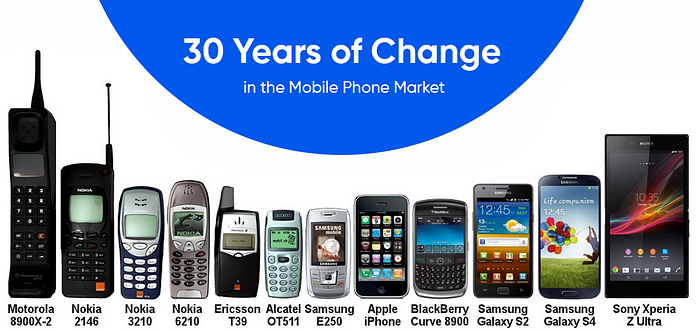30 Years of Change in the Mobile Phone Market

Mobile Phone Market Evolution Since 1993
Three decades ago, the world of mobile phones looked very different than it does now. In 1993, more than half of all cell phones were made by Motorola. But by 2021, its share of the market had dropped to just 2.2%. How did this happen, and how has the mobile industry changed in the last 30 years?
The Birth of Mobile Phones
Motorola is one of the first companies to make cell phones. The DynaTAC 8000X, made by an American company, was one of the first mobile phones to be sold to the public. It came out in 1983. The innovative analog phone cost almost $4,000 and could be used to talk for up to 30 minutes before it needed to be charged. Over the next few years, Motorola released a few more devices, like the MicroTAC 9800X in 1989 and the International 3200 in 1992, and quickly became the industry leader. In the early days of the market, the only serious competitor was the Finnish multinational Nokia, which had bought the early mobile network pioneer Mobira. But by the middle of the 1990s, competitors like Sony and Siemens were getting a foothold, which made Motorola’s dominance less intense. In September 1995, the company had only 32.1% of the market.
By January 1999, Nokia had overtaken Motorola as the biggest maker of clone phones, with 21.4% of the world market. That put it just ahead of Motorola, whose share was 20.8%. One reason Nokia’s popularity was on the rise was that the company was making a lot of progress in the digital phone market. In 1999, the company made the Nokia 7110, the first mobile phone with a web browser.
But Motorola wasn’t just held back by Nokia’s new ideas. In 1999, Motorola ran into trouble when a spin-off project called Iridium SSC went bankrupt. This put a significant strain on the company’s finances, and when the project didn’t work out, the company had to let go of many people. From then on, Motorola’s market share stayed between 14% and 20% until Apple’s iPhone came out in 2007 and turned the mobile phone industry on its head.
The iPhone’s Emergence
When the iPhone came out in 2007, things started to change. In 2007, Steve Jobs gave a keynote speech at the San Francisco Macworld Expo. He described the iPhone as a touchscreen iPod, a revolutionary cell phone, and an internet communications device. A year later, Apple opened the App Store, letting iPhone users download apps and games to their phones. This made the iPhone much more helpful, but it also lets people customize their mobile devices in ways never before.
This was the beginning of a new era of smartphones, but Motorola couldn’t keep up. Apple had 17.4% of the mobile phone market less than two years after the iPhone. In contrast, Motorola’s market share had dropped to 4.9%. By the end of 2021, Apple had about 27.3% of the market for mobile phones around the world. More than half of Apple’s total revenue comes from the iPhone, which is a big reason for the company’s growth.
Pivot Failure
Several things caused Motorola’s decline, but many people say that the biggest problem was that the company didn’t change direction when it needed to. With the release of the iPhone, a new software-driven era began. Motorola was great at making hardware-based phones, but they couldn’t keep up when the times changed. And the animation above shows how BlackBerry (formerly RIM), Palm, Sony, LG, and other companies also failed to change or keep up.
Apple is not the only one. Google’s Android mobile operating system is prevalent, which has helped Samsung, Huawei, and Xiaomi, all of which are competitors, grow and become substantial players in the global mobile phone market. In today’s fast-paced world, businesses need to be able to change directions quickly to stay competitive. Will Apple, Samsung, and other big names in mobile phones stay at the top? Or will other companies like Huawei catch up over the next few years?
